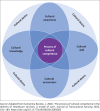Patient perceptions of nurses' cultural competence in public sector hospitals in Gauteng
- PMID: 38962292
- PMCID: PMC11220012
- DOI: 10.4102/hsag.v29i0.2499
Patient perceptions of nurses' cultural competence in public sector hospitals in Gauteng
Abstract
Background: Healthcare institutions are increasingly receiving patients from diverse cultural backgrounds because of migration, rapid urbanisation, and easier access to healthcare. Because the satisfaction of these patients is linked to their perceptions of appropriate cultural care, understanding patient perspectives about cultural competence is imperative. Additionally, patient perceptions about nurses' cultural competence are largely unexplored in South Africa.
Aim: This study explored how the concept of cultural competence is perceived by patients.
Setting: Three public sector hospitals in Gauteng, one from each of the three different levels of public sector hospitals - district (level one), regional (level two), and academic (tertiary, level three).
Methods: This study derives from the qualitative phase of a larger sequential exploratory mixed methods study. The study population was patients in public sector hospitals. A total of 21 interviews were conducted after purposive stratified sampling was done. Data analysis followed Tesch's eight steps of data analysis.
Results: Patients in public sector hospitals in Gauteng believe consideration of culture is important in nursing. They identified the cultural needs they would like nurses to acknowledge, such as being asked about their food preferences and mentioned the need to evaluate nurses' level of cultural competence.
Conclusion: Patient perceptions about cultural competence and their cultural needs can assist nurses in gauging how culturally competent they are and improving care to patients.
Contribution: Patients' perceptions revealed that nurses must be competent to acknowledge their specific cultural needs such as food, language preferences, and religious practices.
Keywords: Gauteng; cultural competence; nurses; patient perceptions; public health sector.
© 2024. The Authors.
Conflict of interest statement
The authors declare that they have no financial or personal relationships that may have inappropriately influenced them in writing this article.
Figures
Similar articles
-
Qualified Nurses' Perceptions of Cultural Competence and Experiences of Caring for Culturally Diverse Patients: A Qualitative Study in Four European Countries.Nurs Rep. 2022 May 5;12(2):348-364. doi: 10.3390/nursrep12020034. Nurs Rep. 2022. PMID: 35645360 Free PMC article.
-
Self-reported cultural competence of public health nurses in a Southeastern U.S. Public health department.Public Health Nurs. 2009 Jan-Feb;26(1):48-57. doi: 10.1111/j.1525-1446.2008.00753.x. Public Health Nurs. 2009. PMID: 19154192
-
Exploring cultural competence of nurses and associated barriers in Ethiopian tertiary hospitals: A qualitative study.Appl Nurs Res. 2021 Dec;62:151511. doi: 10.1016/j.apnr.2021.151511. Epub 2021 Oct 6. Appl Nurs Res. 2021. PMID: 34815007
-
Factors influencing oncology nurses' approaches to accommodating cultural needs in palliative care.J Clin Nurs. 2009 Dec;18(24):3421-9. doi: 10.1111/j.1365-2702.2009.02938.x. J Clin Nurs. 2009. PMID: 20487490 Review.
-
Mixed-methods systematic review: Cultural attitudes, beliefs and practices of internationally educated nurses towards end-of-life care in the context of cancer.J Adv Nurs. 2021 Sep;77(9):3618-3629. doi: 10.1111/jan.14814. Epub 2021 Feb 21. J Adv Nurs. 2021. PMID: 33615526
References
-
- Armstrong, C., Flood, P.C., Guthrie, J., Liu, W., Maccurtain, S. & Mkamwa, T.F., 2010, ‘The impact of diversity management on firm performance. Beyond high performance work systems’, Human Resource Management 49(6), 977–998. 10.1002/hrm.20391 - DOI
-
- Babbie, E. & Mouton, J., 2001, The practice of social research, 1st edn., Oxford University Press, Cape Town.
LinkOut - more resources
Full Text Sources


